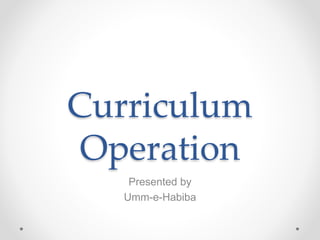
Curriculum Operations
- 2. Curriculum Operation Notions of how the finished products will be operated are built into the design of gardens, bridges, and buildings, and care is called for in anticipating how any such product will actually be used once it is off the drawing board
- 3. Cont. An aircraft design requires consideration of the number and functions of crew members, how maintenance will be provided, and how passengers will board and exit the craft. These operations effectively become part of the design and are difficult to modify after the aircraft is in production
- 4. Cont. So too with curricula. Four key features affect the operation of a curriculum and need to be taken into account in curriculum design: oStudent pathways oStaff deployment oInstructional resources oCurriculum monitoring
- 5. Student Pathways In designing a curriculum, it is necessary to identify the ways in which students will progress through their K-12 years. That information can be developed by posing a series of design-related questions. 1) Will all students follow one path? If there will be more than one path, how many will there be? How will students be grouped on any one path?
- 6. Cont. o On what basis will students be placed on one path or another? Will they change paths at any point in their passage through the curriculum, or only at certain points? 2) How will students advance through the curriculum—grade by grade or grade range by grade range? o Will advancement be automatic, or will promotion be based on demonstrated performance?
- 7. Cont. 3) What are the criteria for a student to enter or exit a particular curriculum subject or course? 4) What is required for graduation?
- 8. Staff Deployment The following set of design-related questions can be used to identify staffing needs and resources: 1) At what point in the elementary-school curriculum will teachers be expected to be subject- matter specialists? In which subjects? o Will secondary-school teachers need to be specialists in a broad domain, such as science, or a specific discipline, such as chemistry?
- 9. Cont. 2) In how many different grades or grade ranges will teachers have to be proficient? o Will they have to cycle through the grades, or specialize in one or two? 3) What skills other than those of traditional classroom teaching will teachers be expected to have: project coaching, seminar management, supervising independent study, overseeing peer teaching, training and supervising noncertified teachers, or others?
- 10. Cont. 4) Will the curriculum design permit teachers to specialize in one or two such functions (in contrast to subject-matter specialization)? 5) Would it be legal to have students or uncertified adults conduct some of the teaching called for by the curriculum? Will teachers connected to the school only by television, the Internet, or regular mail have recognized status as faculty?
- 11. Instructional Resources The following questions are aimed at identifying the need for and availability of such resources: 1) If courses depend heavily on textbooks, how will the books be selected to ensure that they match the learning goals of the curriculum?
- 12. Cont. o If curriculum blocks do not use textbooks, how will the needed materials be identified, reviewed for relevance and accuracy, and selected? How will staff be trained to use them effectively? 2) Will the curriculum operate with whatever spaces and technologies are available, or will it presume the availability of certain information and communications technologies? If so, which ones?
- 13. Cont. 3) If the curriculum will require the use of advanced technologies, what demands will that put on the deployment of teachers and the design of school facilities?
- 14. Curriculum Monitoring The following design-related questions are intended to identify curriculum-monitoring needs and resources: o 1) How will we know whether the curriculum is having the intended effects? What will be the criteria for student performance? How often will major student assessments be made and at what checkpoints? o Who will judge what the findings imply?
- 15. Cont. o What will be done with the results to ensure that deficiencies are corrected? 2) What measures will be taken to detect unwanted and unanticipated side effects that may occur between student assessments? o If it is known that the design may put some students more at risk than others, what special arrangements will be made to monitor their progress? o What will be done about teachers who don’t adapt well to the design?
- 16. Cont. 3) What provisions will be made to monitor the financial, time, and political costs of implementing the curriculum design? o What contingency plans will be in place if the cost of operating the curriculum exceeds estimates by an unacceptable amount?
- 17. Summing up o What pathways through the curriculum are open to students, and how is it determined which students follow which routes? o What capabilities do the staff need to have, and how are staff to be deployed? o What resources are essential to operate the proposed curriculum? o What provisions are built into the curriculum to find out if it is having its intended effects and not having unwanted ones?
